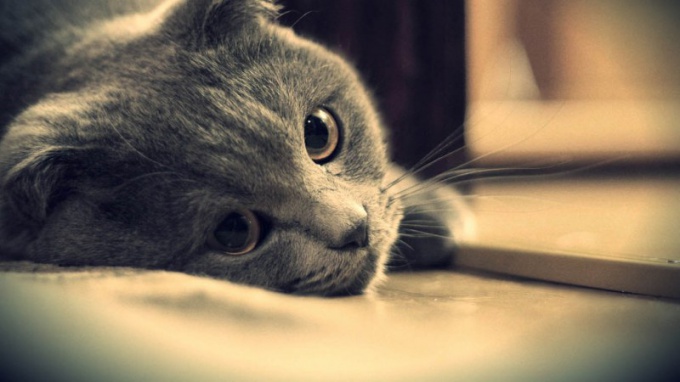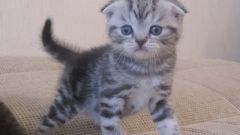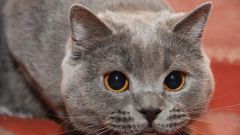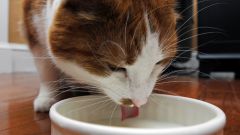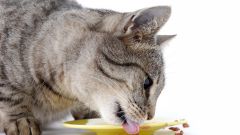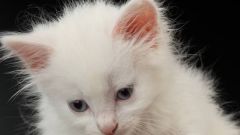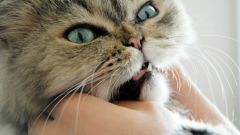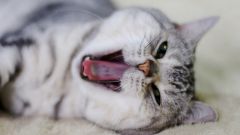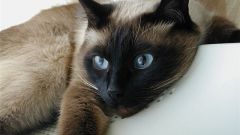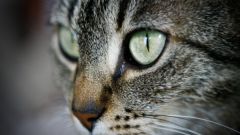You will need
- - mineral oil
- - immunostimulatory drugs ("Vitagel")
- - antiviral drugs
- - syringes of standard size (2, 5 and 10 ml)
- - towel
Instruction
1
Remember, if the cat is vaccinated against panleukopenia (feline distemper) - a viral disease called infectious enteritis. Infection with distemper occurs through contact with the feces or saliva of infected animals. The virus persists for long periods in the environment (grass, etc.), so walking in the street for unvaccinated animal can be dangerous. Symptoms: sunken eyes, and pain (the cat always lies on my belly, tucked under his front legs), giving od food and water, frothy vomiting, diarrhea with dark-green feces or blood. The cat may long to look at a bowl of water, this triggers the swallowing reflex.
2
Measure the animal temperature. To avoid scratches, wrap the cat in a towel, leaving outside only the head and rear part of the body. Lubricate the tip of an ordinary thermometer vaseline (or any other) oil, put the cat on his left side and gently insert the tip into the anus. Wait for 3-5 minutes. The temperature of a healthy cats does not exceed 38 degrees. Panleukopenia when the temperature rises to 40-41 degrees. Lowering the temperature may indicate muscle weakness and dehydration.
3
Touch the cat's stomach by palpation. This procedure requires two people: one needs to keep two hands front and back paws of a cat, the other to diagnose. The cat must be put to one side. Muscle tension, the presence of cones and seals indicate the enlarged lymph nodes of the intestine or stagnation of feces.
4
To confirm or refute a diagnosis, and prescribe treatment can only experienced veterinarian. Upon the slightest suspicion of infectious enteritis, cat must be immediately taken to veterinary clinic. High probability of death, but with timely diagnosis and proper treatment of animal death can be avoided. Usually the cat are assigned: bed rest, forced drinking, glucose injection, immune globulin ("Vitagel", "Immunovet", "Globfel-4", etc.) and antiviral drugs ("Fosprenil", "Anandin", "Kamedonov", etc.).
5
If you don't have the time and desire each time to carry the cat to the clinic, you can leave an animal in-patient treatment (which is very cheap cost) or do injections yourself at home, consult your veterinarian about the technique of injection (subcutaneous or intramuscular) and dosage of the drugs. Advance purchase syringes and medications. To perform the injection requires calmness, confidence and accuracy. Your panic animal instantly feel, will start to worry and break.
6
The reason for refusal specifically from food can be constipation. Water and the pet rarely uses. Normal cat has a bowel movement 1-2 times a day. The absence of the chair more than a day may indicate a stagnation of feces. The reasons may be different - accumulation in the intestine lick fur, etc. Output: the reception of paraffin oil at the rate of 1 ml per 1 kg of body weight. Dial the oil in a syringe without a needle. Ask someone to hold the cat and open her mouth. To avoid aspiration into the respiratory tract, pour the medication on the middle of the tongue, not the throat. It is better to give the oil on an empty stomach in the morning. Mineral oil is not absorbed, but merely envelops and lubricates the intestines, helping stool to reach the masses in a natural way. The result comes after 6-8 hours. If the cat is never emptied, repeat the procedure on the second day. If you experience profuse vomiting and high anxiety animal, contact your veterinarian.
Note
Refusal of food and water can sometimes be caused by an abrupt change to the usual situation (moving into a new apartment, forced finding cats someone from relatives, etc.). The cat is nervous while looking for something in the corners. Should calm the animal and to push them to the bowl, wet the face with water or give a sniff of food. This behavior in the absence of other symptoms usually lasts for 2 days.
Useful advice
Don't put the shots alone, invite to help loved ones, someone to help keep paws. To perform the prescription of the doctor curled up with a cat on the floor quite uncomfortable. During procedures, place the cat on any surface level with your waist or hips (table, windowsill or dresser). Talk with animals is a soothing, gentle tone.
Subcutaneous injections usually are put into the withers. It is necessary to collect and pull the fold of skin in the area of the withers and the shoulder blades of the cat, and then insert the needle parallel to the line of the spine. Before shot release a few drops of medicine from a syringe to aerate.
For intramuscular injection, fixed rear paw of the animal and a quick motion insert the needle at the side, in the femoral muscle.
Subcutaneous injections usually are put into the withers. It is necessary to collect and pull the fold of skin in the area of the withers and the shoulder blades of the cat, and then insert the needle parallel to the line of the spine. Before shot release a few drops of medicine from a syringe to aerate.
For intramuscular injection, fixed rear paw of the animal and a quick motion insert the needle at the side, in the femoral muscle.
